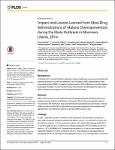Impact and Lessons Learned from Mass Drug Administrations of Malaria Chemoprevention during the Ebola Outbreak in Monrovia, Liberia, 2014
Kühne, Anna
Tiffany, Amanda
Lasry, Estrella
Janssens, Michel
Besse, Clement
Okonta, Chibuzo
Larbi, Kwabena
Pah, Alfred C.
Danis, Kostas
Porten, Klaudia
Background: In October 2014, during the Ebola outbreak in Liberia healthcare services were limited while malaria transmission continued. Médecins Sans Frontières (MSF) implemented a mass drug administration (MDA) of malaria chemoprevention (CP) in Monrovia to reduce malaria-associated morbidity. In order to inform future interventions, we described the scale of the MDA, evaluated its acceptance and estimated the effectiveness. Methods: MSF carried out two rounds of MDA with artesunate/amodiaquine (ASAQ) targeting four neighbourhoods of Monrovia (October to December 2014). We systematically selected households in the distribution area and administered standardized questionnaires. We calculated incidence ratios (IR) of side effects using poisson regression and compared self-reported fever risk differences (RD) pre- and post-MDA using a z-test. Findings: In total, 1,259,699 courses of ASAQ-CP were distributed. All households surveyed (n = 222; 1233 household members) attended the MDA in round 1 (r1) and 96% in round 2 (r2) (212/222 households; 1,154 household members). 52% (643/1233) initiated ASAQ-CP in r1 and 22% (256/1154) in r2. Of those not initiating ASAQ-CP, 29% (172/590) saved it for later in r1, 47% (423/898) in r2. Experiencing side effects in r1 was not associated with ASAQ-CP initiation in r2 (IR 1.0, 95%CI 0.49–2.1). The incidence of self-reported fever decreased from 4.2% (52/1229) in the month prior to r1 to 1.5% (18/1229) after r1 (p
No license information

